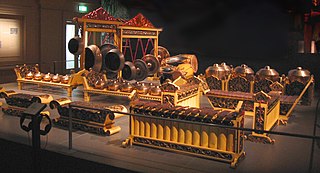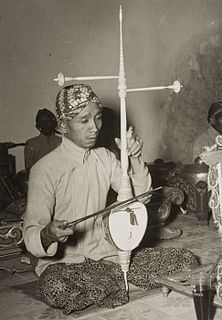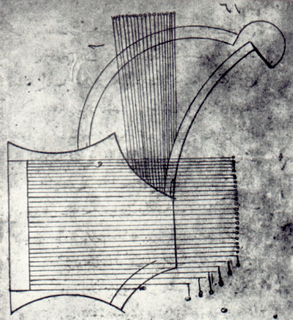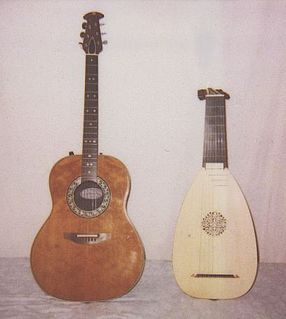
The music of Afghanistan comprises many varieties of classical music, folk music, and modern popular music. Afghanistan has a rich musical heritage and features a mix of Persian melodies, Indian compositional principles, and sounds from ethnic groups such as the Pashtuns, Tajiks and Hazaras. Instruments used range from Indian tablas to long-necked lutes. Afghanistan's classical music is closely related to Hindustani classical music while sourcing much of its lyrics directly from classical Persian poetry such as Mawlana Balkhi (Rumi) and the Iranian tradition indigenous to central Asia. Lyrics throughout most of Afghanistan are typically in Dari (Persian) and Pashto. The multi-ethnic city of Kabul has long been the regional cultural capital, but outsiders have tended to focus on the city of Herat, which is home to traditions more closely related to Iranian music than in the rest of the country.

The sarod is a stringed instrument, used mainly in Hindustani music on the Indian subcontinent. Along with the sitar, it is among the most popular and prominent instruments. It is known for a deep, weighty, introspective sound, in contrast with the sweet, overtone-rich texture of the sitar, with sympathetic strings that give it a resonant, reverberant quality. A fretless instrument, it can produce the continuous slides between notes known as meend (glissandi), which are important in Indian music.

Tar is an Iranian long-necked, waisted lute family instrument, used by many cultures and countries including Iran, Azerbaijan, Uzbekistan, Armenia, Georgia, Tajikistan and others near the Caucasus and Central Asia regions. The older and more complete name of the tār is čāhārtār or čārtār, meaning in Persian "four string",. This is in accordance with a practice common in Persian-speaking areas of distinguishing lutes on the basis of the number of strings originally employed. Beside the čārtār, these include the dotār, setār, pančtār, and šaštār or šeštār.
The music of Central Asia is as vast and unique as the many cultures and peoples who inhabit the region. Principal instrument types are two- or three-stringed lutes, the necks either fretted or fretless; fiddles made of horsehair; flutes, mostly open at both ends and either end-blown or side-blown; and jew harps, mostly metal. Percussion instruments include frame drums, tambourines, and kettledrums. Instrumental polyphony is achieved primarily by lutes and fiddles.

A folk instrument is a musical instrument that developed among common people and usually does not have a known inventor. It can be made from wood, metal or other material. Such an instrument is played in performances of folk music.

The rebab is the name of several related bowed string instruments that independently spread via Islamic trading routes over much of North Africa, Southeast Asia, the Middle East, and parts of Europe.

Badakhshan is a region of Tajikistan and Afghanistan with a unique musical heritage, especially that of the remote Pamiri Ismailis. Badakhshan's unique folk scene is said to be characteristed by the use of many chromatized tones in a narrow melodic range, and the use of a characteristic minor-like scale.
The barbiton, or barbitos, is an ancient stringed instrument related to the lyre known from Greek and Roman classics.

Shahrud (Şahrud) is classified as a "short-necked lute." The word sehrud is of Persian origin, derived from the words sah-i rûd, meaning "king of lutes/large lute." Though Al-Farabi (-950) included an illustration of the sehrud in his Kitâbü'l Musiki, it is very difficult to determine particulars from this drawing. But this old sehrud is completely different from the large ud often encountered in Iranian miniatures of a few centuries later. Thus it is clear that this old name changed in meaning, being applied to a new and different instrument. One of the most-illustrated instruments in Iranian and Ottoman miniatures, the sehrud was generally drawn overlarge. From this standpoint, the miniatures were obviously not realistic. In some miniatures, it is difficult to say whether the instrument depicted is an ud or a sehrud.

Plucked string instruments are a subcategory of string instruments that are played by plucking the strings. Plucking is a way of pulling and releasing the string in such a way as to give it an impulse that causes the string to vibrate. Plucking can be done with either a finger or a plectrum.

Rubab, robab or rabab is a lute-like musical instrument. The rubab is one of the national musical instruments of Afghanistan and other areas inhabited by the Pashtun, Baloch and also played by Sindhi people in Sindh and by Kashmiri people in Kashmir. Three variants of the rubab are the Kabuli rebab of Afghanistan, the Seni rebab of northern India, and the Pamiri rubab of Tajikistan. These proliferated throughout West, Central, South and Southeast Asia. The Kabuli rebab orignates from Afghanistan, and it derives its name from Arabic rebab 'played with a bow'; in Central Asia and the Indian subcontinent, however, the instrument is plucked and is distinctly different in construction.

Pashto music or Də Pəx̌tó ṭang-ṭakór is commonly performed in Afghanistan and Pakistan among Pashtun people.
The mugni (archlute) is a Persian stringed musical instrument which resembles a tar except that the two globes are connected and not separated like the tar's.
The Pamiri rubab is a fretless six-strung lute, carved from a single piece of wood with a skin head. It is played in the Badakhshan region of Tajikistan, as part of the Pamiri musical tradition.
The rawap is a fretted plucked long-necked stringed instrument used in folk music by residents of the Uyghur autonomous region of Xinjiang, Western China. The history of the instrument dates back to the 14th century in southern Xinjiang. It is an instrument of the Uyghurs and Uzbeks. It's particularly associated with Uyghur music and culture.
Qashqari may refer to anything coming from or related to:

Lutes are stringed musical instruments that include a body and "a neck which serves both as a handle and as a means of stretching the strings beyond the body".

The Chardha is a stringed instrument from Pakistan and Afghanistan, from and mainly played in the Hunza valley and Gilgit-Baltistan province. It has 4 or 5 main playing strings made of gut or nylon, and many metal resonance strings.











